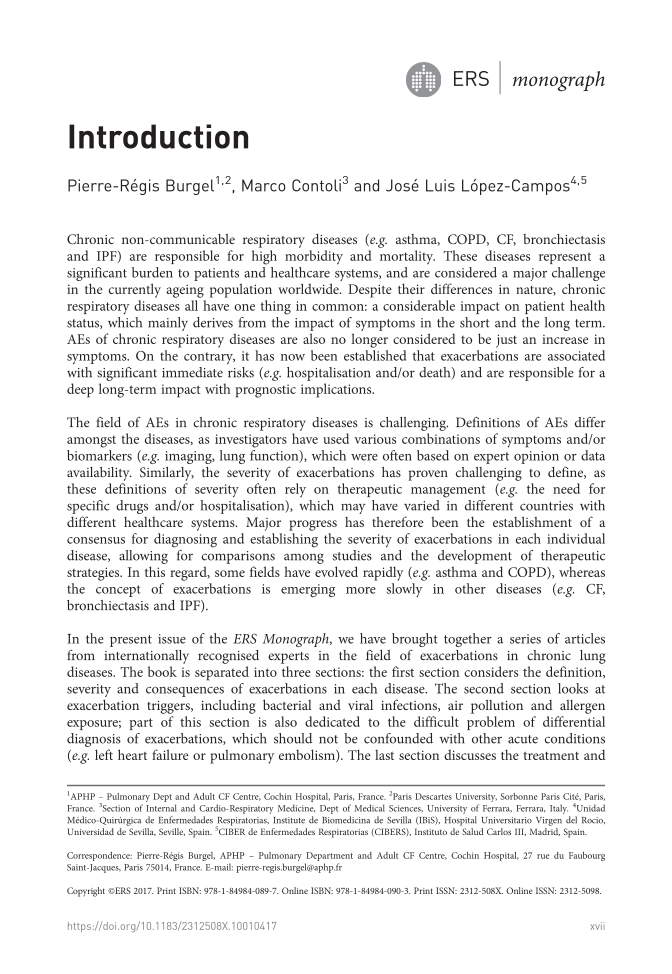ERS | monograph Introduction Pierre-Régis Burgel1,2, Marco Contoli3 and José Luis López-Campos4,5 Chronic non-communicable respiratory diseases (e.g. asthma, COPD, CF, bronchiectasis and IPF) are responsible for high morbidity and mortality. These diseases represent a significant burden to patients and healthcare systems, and are considered a major challenge in the currently ageing population worldwide. Despite their differences in nature, chronic respiratory diseases all have one thing in common: a considerable impact on patient health status, which mainly derives from the impact of symptoms in the short and the long term. AEs of chronic respiratory diseases are also no longer considered to be just an increase in symptoms. On the contrary, it has now been established that exacerbations are associated with significant immediate risks (e.g. hospitalisation and/or death) and are responsible for a deep long-term impact with prognostic implications. The field of AEs in chronic respiratory diseases is challenging. Definitions of AEs differ amongst the diseases, as investigators have used various combinations of symptoms and/or biomarkers (e.g. imaging, lung function), which were often based on expert opinion or data availability. Similarly, the severity of exacerbations has proven challenging to define, as these definitions of severity often rely on therapeutic management (e.g. the need for specific drugs and/or hospitalisation), which may have varied in different countries with different healthcare systems. Major progress has therefore been the establishment of a consensus for diagnosing and establishing the severity of exacerbations in each individual disease, allowing for comparisons among studies and the development of therapeutic strategies. In this regard, some fields have evolved rapidly (e.g. asthma and COPD), whereas the concept of exacerbations is emerging more slowly in other diseases (e.g. CF, bronchiectasis and IPF). In the present issue of the ERS Monograph, we have brought together a series of articles from internationally recognised experts in the field of exacerbations in chronic lung diseases. The book is separated into three sections: the first section considers the definition, severity and consequences of exacerbations in each disease. The second section looks at exacerbation triggers, including bacterial and viral infections, air pollution and allergen exposure part of this section is also dedicated to the difficult problem of differential diagnosis of exacerbations, which should not be confounded with other acute conditions (e.g. left heart failure or pulmonary embolism). The last section discusses the treatment and Copyright ©ERS 2017. Print ISBN: 978-1-84984-089-7. Online ISBN: 978-1-84984-090-3. Print ISSN: 2312-508X. Online ISSN: 2312-5098. Correspondence: Pierre-Régis Burgel, APHP – Pulmonary Department and Adult CF Centre, Cochin Hospital, 27 rue du Faubourg Saint-Jacques, Paris 75014, France. E-mail: pierre-regis.burgel@aphp.fr 1 APHP – Pulmonary Dept and Adult CF Centre, Cochin Hospital, Paris, France. 2 Paris Descartes University, Sorbonne Paris Cité, Paris, France. 3 Section of Internal and Cardio-Respiratory Medicine, Dept of Medical Sciences, University of Ferrara, Ferrara, Italy. 4 Unidad Médico-Quirúrgica de Enfermedades Respiratorias, Institute de Biomedicina de Sevilla (IBiS), Hospital Universitario Virgen del Rocio, Universidad de Sevilla, Seville, Spain. 5 CIBER de Enfermedades Respiratorias (CIBERS), Instituto de Salud Carlos III, Madrid, Spain. https://doi.org/10.1183/2312508X.10010417 xvii
